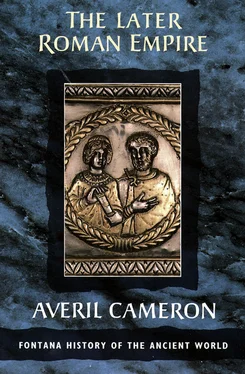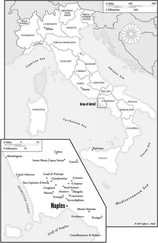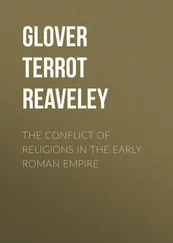There seems to have been little general support for the persecution; it was called off by Galerius in AD 311, and toleration declared for all religions by Constantine and Licinius in the so-called ‘Edict of Milan’ in AD 313 (Eusebius, Church History X.5; Lactantius, DMP 48). The motivation for the persecution itself is far from clear, though the sources confidently blame it on the influence of Galerius. The edict of AD 303 was preceded by a purge of Christians from the army, which itself is said to have followed an incident in AD 299 when diviners at an imperial sacrifice allegedly failed to find the right omens after some Christians who were present had made the sign of the cross. But whatever the immediate reasons, the attempt to control deviant belief and practice suited the ideology of the tetrarchy very well. Diocletian’s and Maximian’s adoption of the styles Jovius and Herculius was part of a heavy emphasis on moral and religious sanctions for their rule, and any sign of offence to the gods, as symbolically demonstrated by the failed divination, was interpreted as extremely dangerous for the future security of the empire. Exactly the same thinking in reverse lay behind Constantine’s adoption of Christianity; he presented himself as duty-bound by God to ensure correct worship throughout the empire, and as liable for personal punishment if he failed.
The style of government adopted by Diocletian and the tetrarchy was undoubtedly severe and authoritarian, at least in theory. Strict social and moral regulation was enjoined on all classes. Much legislation in the fourth century aimed at preventing coloni (tenants) from leaving their estates, keeping decurions (members of town councils) from abandoning their place of residence and ensuring hereditary succession in trades and crafts, and is expressed in luridly moralizing language typical of late Roman laws, and accompanied with threats of dire punishments for disobedience. If taken at face value, this legislation can look very much like the apparatus of a totalitarian state. We shall return to it later (see especially Chapter VII); for the moment it is enough to point out that there was a large gap between theory and practice, and that the motivation was something more immediate than social repression, namely the paramount need to ensure tax revenue and production in the face of actual governmental weakness. The old view, held for example by Jones, according to which Diocletian was credited with creating the institution of the ‘colonate’ and effectively tying the free population to the land, has increasingly come under criticism in recent years: well before Diocletian, private tenants in Egypt had paid their taxes through their landlord as intermediary, and it was perhaps this situation which Diocletian now made hereditary, thus regularizing an existing situation rather than imposing a new one. Nor did his legislation introduce a new and unified system for the whole empire; in contrast, current research emphasizes the regional variety which continued to hold in spite of the appearance of centralization sometimes given by the existence of the law codes.
The moralizing, threatening vocabulary of imperial legislation did however indeed become habitual; it is only too apparent from the pages of Ammianus, who employs the same kind of terminology for his own judgements. But the abundant evidence which is available from the reign of Constantine onwards, and especially from the later fourth century, suggests that hard though life might be, the regimentation preached by Diocletian and his colleagues did not in fact prevail.
Diocletian was nothing if not true to his aims: he abdicated together with his senior colleague Maximian on 1 May, AD 305, and retired to his palace at Split, refusing to return to political life thereafter. Lactantius, who wished to give him an exemplary death as a persecutor, claims that he starved himself to death in AD 311 or 312 ( DMP 42), but other sources have him living longer. Diocletian had no direct heirs and the tetrarchy hardly survived his retirement. Constantine succeeded his father Constantius in AD 306, secured his position as Augustus by an alliance with Maximian in AD 307 and soon proceeded to work for the elimination of his rivals. One of those who fell victim to him was Maximian himself (AD 310), and he defeated Maximian’s son, Maxentius, in AD 312. Once sole emperor, Constantine was to set great changes in motion which have invited both contemporaries and modern historians to contrast him sharply with Diocletian; but he was himself a product of the tetrarchy and was in many ways Diocletian’s heir – many of the social, administrative and economic developments in his reign simply brought Diocletian’s innovations to their logical conclusion.
IV The New Empire: Constantine
EVEN MORE THAN Diocletian, Constantine suffers from bias in the verdicts of both ancient and modern commentators. The problem centres on his support for Christianity, which fundamentally changed the fortunes of the Christian church and may well be responsible for its later history as a world religion. Our main contemporary source, Eusebius of Caesarea, was the author of a Church History which turned into a glorification of Constantine, and later became Constantine’s panegyrist in his Life of Constantine . Lactantius, too, sharply differentiates the virtuous Constantine from the wicked Diocletian, although in his case at least, since he was writing his tract On the Deaths of the Persecutors ( DMP ), on any dating, before the final victory of Constantine over Licinius in AD 324, Licinius is allowed an equal rating with Constantine. The relevant Latin Panegyrics naturally give maximum credit to Constantine and arrange their historical material accordingly. For the secular aspects of the reign, we unfortunately depend a good deal on Zosimus’s New History , which is not only equally biased (albeit in the opposite direction) but also naively distorted. As for documentary proof, much of the evidence for Constantine’s legislation is contained only in the Life of Constantine by Eusebius, and thereby comes under some suspicion (see Chapter II). Finally, though the imperial letters on the subject of Donatism preserved in the Appendix to Optatus’s history of the Donatist controversy are now normally accepted as genuine (and if so are highly revealing of Constantine’s own mentality), we have to remember that they were preserved in a Catholic milieu and represent only one side of the controversy.
As for modern historians, one must be equally on the look-out for bias, open or hidden. Sometimes it takes a very overt form: as a saint of the Orthodox church and the founder of Constantinople, Constantine is often straightforwardly and favourably presented as the founder of Byzantine civilization; his contribution to its religious development is thus what is most emphasized. Others, especially the nineteenth-century German historian Jacob Burckhardt and the twentieth-century Belgian scholar Henri Grégoire, have sought to denigrate the integrity of Constantine by attacking the credibility of Eusebius, an approach that has provoked a defence both of Constantine and of Eusebius, notably by Norman Baynes, in his essay, Constantine the Great and the Christian Church . Since to write about Constantine at all entails choosing between the conflicting sources, or at least, taking a view about the credibility of Eusebius, the main Christian source, it is impossible to avoid being drawn into these controversies. Constantine is one of the most important figures in the history of the Christian church; given the significance of the latter in our culture, even apparently neutral studies tend at times to reveal a hidden agenda. A critical approach is therefore needed, though not necessarily an ultra-sceptical one.
Читать дальше












